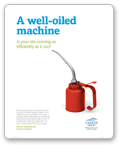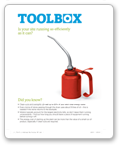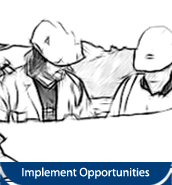
-
A well-oiled machine
 A well-oiled machine
A well-oiled machine -
Don't get in too deep
 Don't get in too deep
Don't get in too deep -
Easy does it
 Easy does it
Easy does it -
Get on your soapbox
 Get on your soapbox
Get on your soapbox -
Got it covered
 Got it covered
Got it covered -
Handle with care
 Handle with care
Handle with care -
It all adds up
 It all adds up
It all adds up -
It's in your hands
 It's in your hands
It's in your hands -
On target
 On target
On target -
Switch it off
 Switch it off
Switch it off -
Watch your speed
 Watch your speed
Watch your speed -
Wrap it up
 Wrap it up
Wrap it up
-
Toolbox TalkBurner Optimisation
 Burner Optimisation
Burner Optimisation -
Toolbox TalkCompressed Air

Tips for using compressed air in a more efficient way to save up to 30% of your site's energy consumption.

 Compressed Air
Compressed Air -
Toolbox TalkEnergy Awareness

Tips for recognising and reducing energy consumption to save up to 10% of your site's energy consumption.

 Energy Awareness
Energy Awareness -
Toolbox TalkInsulation

Tips for ensuring that all appropriate site areas are insulated and save up to 10% of your site's heat load.

 Insulation
Insulation -
Toolbox TalkMoisture Control

Tips for ensuring that moisture levels in aggregate are kept as low as possible to save up to 15% in energy consumption.

 Moisture Control
Moisture Control -
Toolbox TalkOptimised Site Running
 Optimised Site Running
Optimised Site Running -
Toolbox TalkPumping

Tips for ensuring your site's water pumps are running correctly and efficiently and save up to 50% of your pumping energy.

 Pumping
Pumping -
Toolbox TalkVSDs

Tips for identifying where Variable Speed Drives can be fitted or cheaper alternatives used to make significant savings.

 VSDs
VSDs -
Toolbox TalkEnergy Management
 Energy Management
Energy Management
-
ToolEnergy Saving Assessment Tool

This tool is designed to provide an quick assessment of the energy saving potential based on the information provided by the user and on rules of thumb.
To save this tool Right Click the icon or download button and click Save As

 Energy Saving Tool
Energy Saving Tool -
User GuideEnergy Saving Assessment Tool

This is the User Guide for the Energy Saving Assessment Tool. It provides information and instructions on how to use the tool.

 Energy Saving Tool User Guide
Energy Saving Tool User Guide
-
Case StudyAsphalt Plant

This case study is an introduction to the energy saving measures that are possible at Asphalt Plants.

 Asphalt Plant
Asphalt Plant -
Case StudySand & Gravel Quarry
 Sand & Gravel Quarry
Sand & Gravel Quarry -
Case StudyCrushed Rock Quarry
 Crushed Rock Quarry
Crushed Rock Quarry
Energy Awareness
The journey to carbon and energy reduction in a crushed rock quarry starts with raising awareness. It is essential to have all staff on board in any drive to reduce emissions and to ensure that everyone understands why the scheme is important. Energy efficiency saves money, reduces carbon emissions and is increasingly important to customers, regulators and other industry contacts.
On a practical level, most staff are involved in turning on and off appliances and equipment - a critical element in any carbon reduction scheme. Taking a broader perspective, it can also prove beneficial and productive to engage all stakeholders, including customers, suppliers and investors, to help achieve carbon reduction goals.
This stage of the journey raises awareness of the importance of, and reason for, reducing carbon emissions on site. Resources include various Toolbox Talks and How-To Guides which increase awareness and advise how to identify and implement measures to reduce energy use and carbon emissions. Opportunities exist across the range of fixed and mobile plant in every limestone, igneous and sandstone quarry.
Energy Awareness
The journey to carbon and energy reduction in a sand and gravel quarry starts with raising awareness. It is essential to have all staff on board in any drive to reduce emissions and to ensure that everyone understands why the scheme is important. Energy efficiency saves money, reduces carbon emissions and is increasingly important to customers, regulators and other industry contacts.
On a practical level, most staff are involved in turning on and off appliances and equipment - a critical element in any carbon reduction scheme. Taking a broader perspective, it can also prove beneficial and productive to engage all stakeholders, including customers, suppliers and investors, to help achieve carbon reduction goals.
This stage of the journey raises awareness of the importance of, and reason for, reducing carbon emissions on site. Resources include various Toolbox Talks and How-To Guides which increase awareness and advise how to identify and implement measures to reduce energy use and carbon emissions. Opportunities exist across the range of fixed and mobile plant in every sand and gravel quarry.
Energy Awareness
The journey to carbon and energy reduction in an asphalt plant starts with raising awareness. It is essential to have all staff on board in any drive to reduce emissions and to ensure that everyone understands why the scheme is important. Energy efficiency saves money, reduces carbon emissions and is increasingly important to customers, regulators and other industry contacts. Asphalt plants have the highest relative energy use in the aggregates sector, providing significant opportunities for energy reduction through, for example, more effective burner optimization and insulation.
On a practical level, most staff are involved in turning on and off appliances and equipment - a critical element in any carbon reduction scheme. Taking a broader perspective, it can also prove beneficial and productive to engage all stakeholders, including customers, suppliers and investors, to help achieve carbon reduction goals.
This stage of the journey raises awareness of the importance of, and reason for, reducing carbon emissions on site. Resources include various Toolbox Talks and How-To Guides which increase awareness and advise how to identify and implement measures to reduce energy use and carbon emissions.






